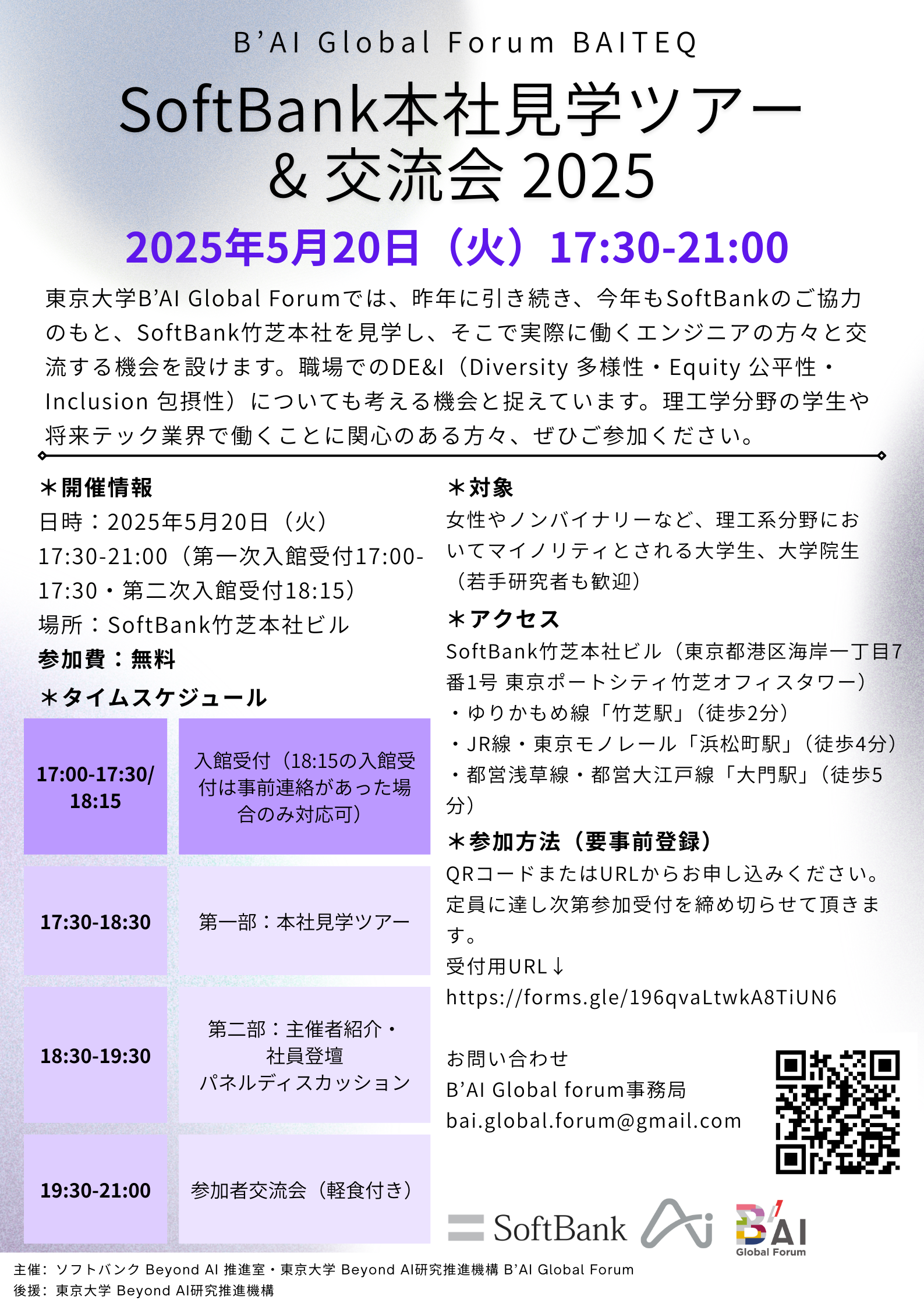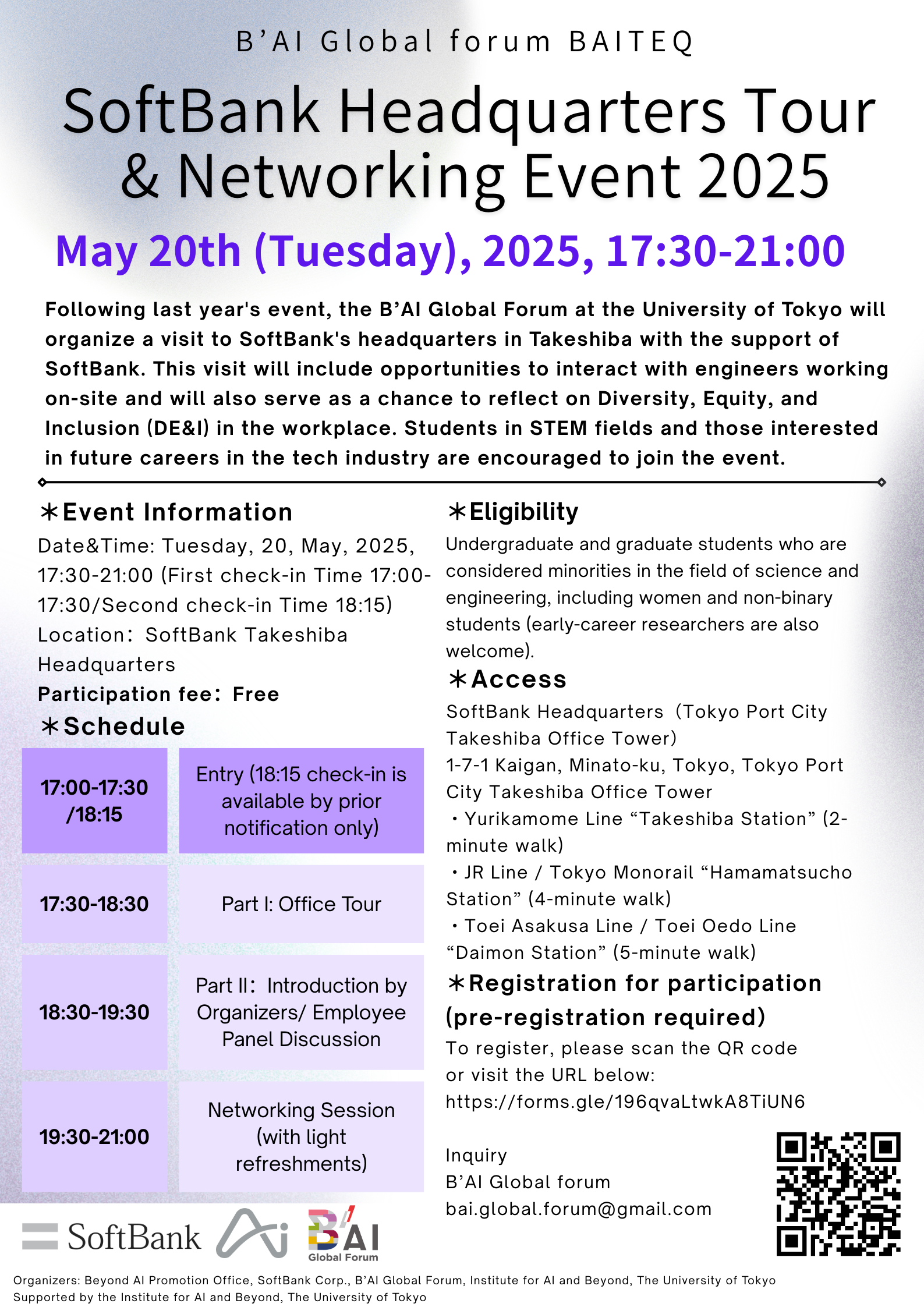第80回研究セミナー:非公開 The 80th Research Seminar : Closed to the public
2025年12月2日、第80回研究セミナーを開催いたしました。
セミナーの内容は非公開となります。
The 80th Research Seminar was held on December 2nd, 2025.
The seminar was closed to the public.
2025年12月2日、第80回研究セミナーを開催いたしました。
セミナーの内容は非公開となります。
The 80th Research Seminar was held on December 2nd, 2025.
The seminar was closed to the public.
2025年11月4日、第79回研究セミナーを開催いたしました。
セミナーの内容は非公開となります。
The 79th Research Seminar was held on November 4th, 2025.
The seminar was closed to the public.
2025年10月7日 第78回研究セミナー「視覚情報の表現特性から見る脳と人工知能の違い」を開催いたしました。
スピーカー:吉田 盛史 東京大学 大学院医学系研究科 講師
The 78th Research Seminar was held on October 7, 2025.
Title: Visual representation difference between the brain and AI
Speaker: Takashi Yoshida (Lecturer, Graduate School of Medicine, The University of Tokyo)
2025年9月2日 第77回研究セミナー「AIで読み解く脳と心、それと量子計算を脳データ解析に使う試みについて」を開催いたしました。
スピーカー:間島 慶 国立研究開発法人 量子科学技術研究開発機構 研究員
The 77th Research Seminar was held on September 2, 2025.
Title: Neural decoding of mental imagery using AI, and some applications of quantum-inspired algorithms to neural data analysis
Speaker: Kei Majima (Researcher, National Institutes for Quantum Science and Technology)
2025年8月5日 第76回研究セミナー「物理極限学習ー量子指紋による機械学習機能の創出ー」を開催いたしました。
スピーカー:
日置友智 東京大学 大学院工学系研究科 物理工学専攻 助教
押金こよみ 東京大学 大学院工学系研究科 物理工学専攻 修士課程2年
The 76th Research Seminar was held on August 5, 2025.
Title: Physical Extreme Learning: Enabling Machine Learning Functions via Quantum Fingerprint
Speaker:
Tomosato Hioki (Research Associate, Department of Applied Physics, Graduate School of Engineering, The University of Tokyo)
Koyomi Oshigane (Second year MA student, Department of Applied Physics, Graduate School of Engineering, The University of Tokyo)
2025年7月1日 第75回研究セミナー「Unsupervised domain adaptation in the era of foundation models」を開催いたしました。
スピーカー: Thomas Westfechtel 東京大学 先端科学技術研究センター 助教
The 75th Research Seminar was held on July 1, 2025.
Title: Unsupervised domain adaptation in the era of foundation models
Speaker: Thomas Westfechtel (Assistant Professor, Research Center for Advanced Science and Technology, The University of Tokyo)
2025年6月3日、第74回研究セミナーを開催いたしました。
セミナーの内容は非公開となります。
The 74th Research Seminar was held on June 3rd, 2025.
The seminar was closed to the public.
2025年5月13日 第73回研究セミナー「位置情報共有をめぐる若者の実践とその背景ー二都市における質的調査から」を開催いたしました。
スピーカー: 藤田 結子 東京大学 大学院情報学環・学際情報学府 准教授
The 73rd Research Seminar was held on May 13, 2025.
Title: Youth Practices and Contexts of Location Sharing: A Qualitative Study in Two Cities
Speaker: Yuiko Fujita (Associate Professor, Graduate School of Interfaculty Initiative in Information Studies, The University of Tokyo)
東京大学B’AI Global Forumでは、STEM領域やテック産業における多様性・公平性・包摂性(DE&I)の推進を目指し、「BAITEQ(B’AI Tech Equity)」プロジェクトを展開しています。これまで、同分野・産業で活動する多様な人々が気軽に集い、交流し、意見を共有できる場づくりに取り組んできました。
昨年に引き続き、今年もSoftBankのご協力のもと、SoftBank竹芝本社を訪問し、実際に現場で働くエンジニアの方々と交流する機会を設けます。あわせて、職場でのDE&Iについても考える機会と捉えています。
■ 主催:ソフトバンク Beyond AI推進室・東京大学 Beyond AI研究推進機構 B’AI Global Forum
■ 後援:東京大学 Beyond AI 研究推進機構
■ 日時: 2025年5月20日(火)17:30〜21:00(日本時間)
■ 場所:SoftBank竹芝本社ビル
■ 言語:日本語
■ 参加方法:参加には事前申し込みが必要となります。下記URLよりお申し込みください。
(申込締切:2025年5月14日)
https://forms.gle/196qvaLtwkA8TiUN6
■ お問い合わせ:
B’AI Global Forum事務局
bai.global.forum[at]gmail.com([at]を@に変えてください)
At the B’AI Global Forum of the University of Tokyo, we are advancing the “BAITEQ (B’AI Tech Equity)” project to promote diversity, equity, and inclusion (DE&I) in STEM fields and the tech industry. Our initiatives have focused on creating spaces where people from diverse backgrounds working in these fields can come together, connect, and exchange ideas.
Following last year’s successful event, we are once again partnering with SoftBank to organize a visit to SoftBank’s headquarters in Takeshiba. Participants will have the opportunity to meet and engage with engineers working onsite, while also reflecting on DE&I practices in the workplace.
We warmly invite students in STEM fields and anyone interested in pursuing a career in the tech industry to join us!
■ Date(s): Tuesday, May 20, 2025, 5:30-9:00 PM (JST)
■ Venue: SoftBank Takeshiba Headquarters
■ Language: Japanese
■ How to register: Pre-registration required. Please register by May 14 via the link below.
https://forms.gle/196qvaLtwkA8TiUN6
■ Organizer: Beyond AI Promotion Office, SoftBank Corp.; B’AI Global Forum, Institute for AI and Beyond, The University of Tokyo
■ Supported by The Institute for AI and Beyond, The University of Tokyo
■ Inquiry
B’AI Global Forum Office
bai.global.forum[at]gmail.com(Please change [at] to @)
For more details: https://baiforum.jp/en/events/en091


2025年4月1日、第72回研究セミナーを開催いたしました。
セミナーの内容は非公開となります。
The 72nd Research Seminar was held on April 1st, 2025.
The seminar was closed to the public.